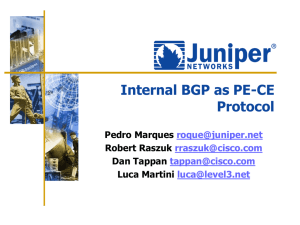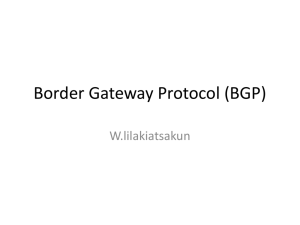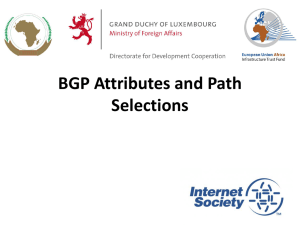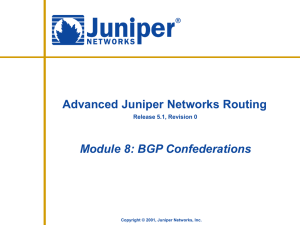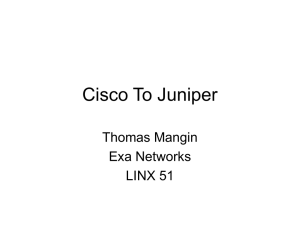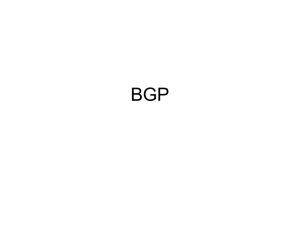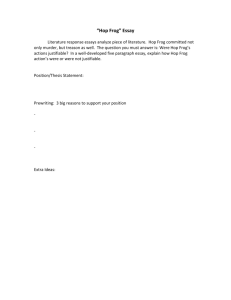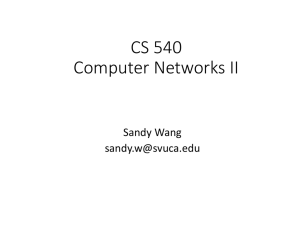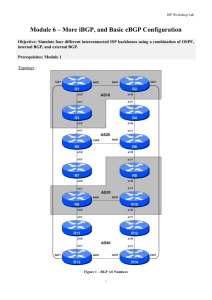BGP Attributes - APNIC Training
advertisement
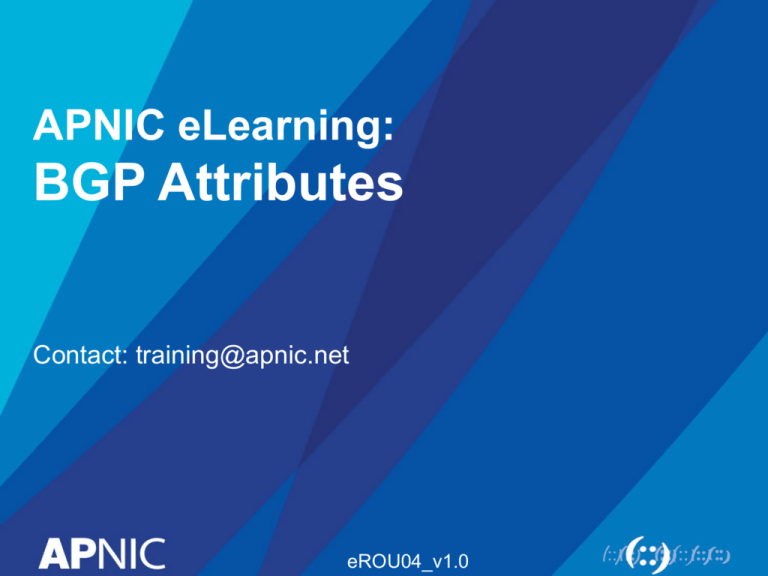
APNIC eLearning: BGP Attributes Contact: training@apnic.net eROU04_v1.0 Overview • BGP Attributes • Well-known and Optional Attributes • AS Path • AS Loop Detection • iBGP and eBGP Next Hop • Next Hop Best Practice • BGP Origin, Local Preference, MED, and Community Attributes • BGP Route Selection Process BGP Attributes • Well-known attributes – must be supported by every BGP implementation • Mandatory attributes – must be included with every route entry. If one attribute is missing, it will result in an error message – Ex: ORIGIN, AS_PATH, NEXT_HOP, LOCAL_PREF • Discretionary attributes – every BGP router must recognize, but they don’t have to be present with every route entry – Ex. ATOMIC_AGGREGATE • Optional attributes – not necessarily supported by all BGP implementations. It can be either transitive or non-transitive. – AGGREGATOR, COMMUNITY, MULTI_EXIT_DISC BGP Attributes BGP metrics are called path attributes. Here is the classifications BGP attributes: Well-known mandatory – AS-Path – Next-hop – Origin Optional transitive - Community - Aggregator Well-known discretionary Optional non-transitive − Local preference − Atomic aggregate - Multi-exit-discriminator (MED) Well-Known Attributes • Must be recognized by all compliant BGP implementations • Are propagated to other neighbors Well-Known Mandatory Attributes - Must be present in all update messages - AS Path - Next-hop - Origin Well-Known Discretionary Attributes - May be present in update messages - Local preference - Atomic aggregate Optional Attributes • Recognized by some implementations (could be private) expected not to be recognized by everyone • Recognized optional attributes are propagated to other neighbors based on their meaning Optional Transitive Attributes - If not recognized, are marked as partial and propagated to other neighbors - Community - Aggregator Optional Non Transitive attributes - Discarded if not recognized - Multi Exit Discriminator (MED) AS Path Attribute • Sequence of ASes a route has traversed • Used for – Loop detection – Path metrics where the length of the AS Path is used as in path selection AS Path Loop Detection • 180.10.0.0/16 is not accepted by AS100 as the prefix has AS100 in its AS-PATH • This is loop detection in action AS Path Attribute (2 byte and 4 byte) • Internet with 16-bit and 32-bit ASNs – 32-bit ASNs are 65536 and above – AS-PATH length maintained AS Path and AS4 Path Example Router5: Network Next Hop Metric LocPrf Weight *> 2001::/32 2406:6400:F:41::1 Path 0 23456 38610 6939 I *i 2406:6400:D::5 0 *> 2001:200::/32 100 0 45192 4608 4826 6939 i 2406:6400:F:41::1 0 23456 38610 6939 2500 i *i 2406:6400:D::5 0 100 0 45192 4608 4826 6939 2500 i eBGP Next Hop • The IP address to reach the next AS – Router A advertise 150.10.0.0/16 and 160.10.0.0/16 to router – B in eBGP with next hop 150.10.1.1 (Change it to own IP) – Router B will update Router C in iBGP keeping the next hop unchanged • Well known mandatory attribute iBGP Next Hop • Next hop is iBGP router loopback address • Recursive route look-up • Loopback address need to announce through IGP (OSPF) • iBGP send update next-hop unchanged Next Hop Best Practice • IOS default is for external next-hop to be propagated unchanged to iBGP peers – This means that IGP has to carry external next-hops – Forgetting means external network is invisible – With many eBGP peers, it is unnecessary extra load on IGP • ISP Best Practice is to change external next-hop to be that of the local router – neighbor x.x.x.x next-hop-self Next Hop Self Configuration • Next hop default behavior can be changed by using nexthop-self command • Forces all updates for this neighbor to be advertised with this router as the next hop • The IP address used for next-hop-self will be the same as the source IP address of the BGP packet BGP Origin Attribute • The origin attribute informs all autonomous systems how the prefix introduced into BGP • Well known mandatory attribute • Three values: IGP, EGP, incomplete – IGP generated by BGP network statement – EGP generated by EGP – Incomplete redistributed from another routing protocol BGP Origin Attribute Example Status codes: s suppressed, d damped, h history, * valid, > best, i - internal, r RIB-failure, S Stale Origin codes: i - IGP, e - EGP, ? – incomplete Network Next Hop Metric LocPrf Weight Path *> 2001::/32 2406:6400:F:41::1 0 23456 38610 6939 i *i 2406:6400:D::5 0 100 0 45192 4608 4826 6939 i BGP Local Preference Attribute • Local preference is used to advertise to IBGP neighbors only about how to leave their AS (Outbound Traffic). • Paths with highest preference value are most desirable • Local preference attribute is well-known and discretionary and is passed only within the AS • Cisco Default Local Pref is 100 BGP Local Preference Attribute • For destination 160.10.0.0/16 Router A advertise local pref 500 and Router B advertise local pref 800 in iBGP • 800 will win best path (Router B) BGP Local Pref Attribute Example Network Next Hop Metric LocPrf Weight Path *> 2001::/32 2406:6400:F:41::1 0 23456 38610 6939 i *i 6939 i 2406:6400:D::5 0 100 0 45192 4608 4826 *> 2001:200::/32 2406:6400:F:41::1 0 23456 38610 6939 2500 i *i 2406:6400:D::5 6939 2500 i 0 100 0 45192 4608 4826 BGP MED Attribute • MED is used to advertise to EBGP neighbors about how to exit their AS to reach networks owned by this AS (Incoming traffic). • MED is sent to EBGP neighbors only. • The paths with the lowest MED value are the most desirable • The MED attribute is optional and non transitive BGP MED Attribute • For prefix 120.68.1.0/24 Router B send MED 1000 and router A send MED 2000 to eBGP neighbor • Incoming traffic from AS200 will choose Router B since lowest MED will win BGP MED Example Network Next Hop Metric LocPrf Weight Path *> 2001::/32 2406:6400:F:41::1 0 23456 38610 6939 i * i 2406:6400:D::5 0 100 0 45192 4608 4826 6939 i *> 2001:200::/32 2406:6400:F:41::1 0 23456 38610 6939 2500 i * i 2406:6400:D::5 0 100 0 45192 4608 4826 6939 2500 i BGP Community Attribute • Community is a tagging technique to mark a set of routes • Upstream service provider routers can then use these flags to apply specific routing polices (i.e local preference etc) within their network • Represented as two 16 bit integers (RFC1998) • Common format is <local-ASN>:xx • I.e 0:0 to 0:65535 and 65535:0 to 65535:65535 are reserved • Very useful in applying policies within and between ASes • Optional & transitive attribute BGP Route Selection Process • Step 1: Prefer highest weight (local to router) • Step 2: Prefer highest local preference (global within AS) • Step 3: Prefer route originated by the local router • Step 4: Prefer shortest AS path • Step 5: Prefer lowest origin code (IGP < EGP < incomplete) • Step 6: Prefer lowest MED (from other AS) • Step 7: Prefer EBGP path over IBGP path • Step 8: Prefer the path through the closest IGP neighbor • Step 9: Prefer oldest route for EBGP paths • Step 10: Prefer the path with the lowest neighbor BGP router ID Questions • Please remember to fill out the feedback form – <survey-link> • Slide handouts will be available after completing the survey APNIC Helpdesk Chat Thank you! End of Session
